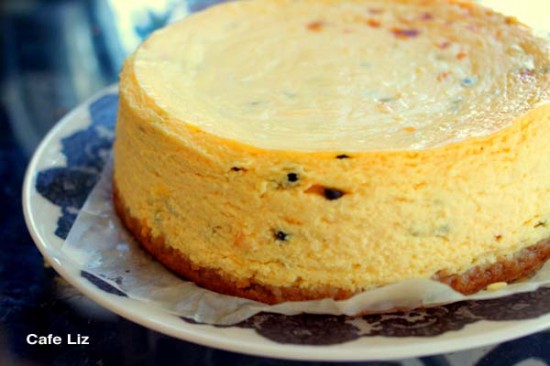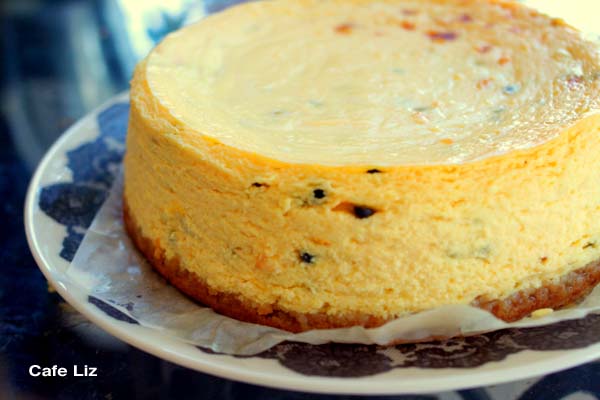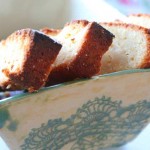
This cheesecake has a fabulous, tangy flavor, thanks to the passion fruit, orange and lemon. It also almost ended in complete and total disaster due to my impatience.
It’s been quite a while since I’ve made a cheesecake — about 51 weeks, right around last year’s Shavuot, to be precise — and I kind of forgot the importance of letting the cheesecake take its dear sweet time to cool down. In my haste, I removed the baking ring a few minutes after this gorgeous, golden cheesecake came out of the oven, and watched in horror as the perfect top split and the cake collapsed into a pile on its tinfoil wrapping.
Fortunately, not all was lost. In fact, very little was lost — just the cake’s perfect, unbroken top. This is because cheesecakes solidify as they cool. I hastily crammed the tinfoil back into the baking ring, and stuck everything back in the oven for half an hour, for good measure. When I took it out after this second round, I let it cool properly — slowly, over several hours — and only then did I attempt to remove the baking ring. Lo and behold, I had a round cake again.
In any case, you can learn from my errors. You can also learn from my successes, because the following cheesecake came out much better — fully intact. (That’s the cake in the top photo …. not the messy first attempt.)
I use a baking ring, mostly because baking rings come in a wider range of sizes than spring-form pans. To use a baking ring, you sit it on top of a square of baking paper slightly larger than the base of the ring, and then wrap the paper and the outside of the ring in at least one layer of tinfoil. The foil gets tucked neatly around the upper edges of the ring — more than that, and it’ll get stuck in the cake. You probably will want to put the ring on an additional surface, to give the cake proper support from underneath and to make sure nothing drips into the oven.
You also can make this a more standard size, such as a 20- or 24-centimeter cake, without changing the quantities — you’ll just get a thinner cake. In a 24-centimeter diameter pan, the cheesecake portion (not counting the crust) will be about 1 centimeter thick. Doubling the recipe for a pan this size could also work.
You can find my dulce de leche cheesecake recipe here.

For one 16-centimeter cake (approximately 6 centimeters tall):
For the filling:
600 grams cream cheese (I use 500 grams 5% fat, and 100 grams 30% fat)
200 grams passion fruit (weight including shells)
6 tablespoons sugar
2 eggs
zest of 1 lemon
zest of 1 orange
juice of 1/2 lemon
For the crust:
120 grams plain cookies
40 grams butter
For the glaze (optional):
2 tablespoons sugar
1/2 cup orange juice
Preheat the oven to 160 degrees Celsius.
Blend the butter and cookies in a food processor until you have thick crumbs, and pack into the bottom of your prepared baking ring or spring-form pan, so that you have an even layer of crust.
Cut open the passion fruits, and scoop out the yellow insides into a bowl. I don’t bother to strain out the seeds, since that’s what makes the cake look like it’s passion-fruit flavored, but you could. Mix with the rest of the filling ingredients.
Pour the filling into the crust, and put into the oven. After about 10 minutes, cover the top of the cheesecake with foil, to keep it from browning. Let bake for about an hour.
Then, turn off the oven, and let the cake cool down in the oven for at least 1/2 hour (you can crack the door open slightly.)
Once the cake begins to approach room temperature, take it out of the oven and let it sit for a few more hours, until it is completely cool. At this point, you can safely remove the baking ring/spring form pan without the cake falling apart. If you followed all these steps patiently, your cake will look like the one in the top photo, and not the disaster I described. Chill.
Top with glaze before serving (optional): Reduce the orange juice and the sugar in a saucepan, until thick and glossy. Spoon over slices of cake before serving. The glaze will be absorbed into the cake if left to sit on it in the fridge; therefore, it’s best saved for the last minute.




